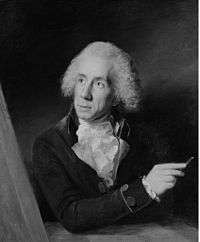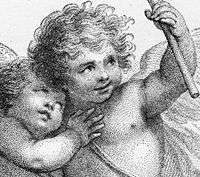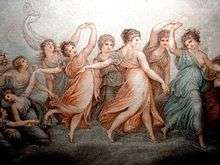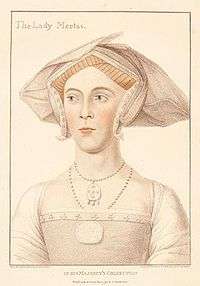Francesco Bartolozzi





Francesco Bartolozzi RA (Florence, 21 September 1727 – 7 March 1815, Lisbon) was an Italian engraver, whose most productive period was spent in London.
Early life
Bartolozzi was born in Florence. He was originally destined to follow the profession of his father, a gold- and silver-smith, but he manifested so much skill and taste in designing that he was placed under the supervision of two Florentine artists, including Ignazio Hugford and Giovanni Domenico Ferretti who instructed him in painting. After devoting three years to that art, he went to Venice and studied engraving. He particularly admired the work of Joseph Wagner.[1]
Early career
His first productions in Venice were plates in the style of Marco Ricci, Zuccarelli, and others, while working for Wagner, which began to draw attention. He then moved for a short time to Rome, where he completed a set of engravings representing frescoes at Grottaferrata by Domenichino depicting the life of St Nilus. He soon returned to Venice and left for London in 1764.
Career in London
He lived in London for nearly forty years. He produced an enormous number of engravings, including Clytie after Annibale Carracci, and of the Virgin and Child, after Carlo Dolci. A large proportion of them are from the works of Cipriani and Angelica Kauffman. Bartolozzi also contributed a number of plates to Boydell's Shakespeare Gallery. He also drew sketches of his own in red chalk. Soon after arriving in London, he was appointed 'Engraver to the King' with an annual salary of £300. He was elected a founding member of the Royal Academy in 1768, and in 1802 became the founding President of the short-lived Society of Engravers.
His pupils were Michele Benedetti, Ignatius Joseph van den Berghe, Thomas Cheesman, Lambertus Antonius Claessens, Daniel Gardner, Christiaan Josi, Johan Fredrik Martin, Conrad Martin Metz, Luigi Schiavonetti, John Keyse Sherwin, Heinrich Sintzenich, Peltro William Tomkins, Don Bernardo Zilotti,[2] and Gabriel Scorodomoff.[3]
Bartolozzi was not the inventor of the so-called crayon manner of engraving, which imitated the subtleties of chalk drawings, but he made it the fashion.
Later life
In 1802, Bartolozzi accepted the post of director of the National Academy of Lisbon, the city where he died. His son Gaetano Stefano Bartolozzi, born in 1757, was also an engraver, and the father of Madame Vestris.
Works
Ticozzi and Bryan both published lists of his output, including:
Original etchings
- Abraham and the Angels.
- The Miracle of the Manna.
- Job abandoned by his Friends.
- Charity, an oval; inscribed Ipse feci .
- The Origin of Painting (1787).
- The Virgin and Infant; (circular).
Etchings after masterworks
- St. Francis of Sales triumphs over Heresy; after Ottavio Amiconi.
- St. Luke paints the Portrait of the Virgin; after Cantarini.
- The Adulteress before Christ; after Agostino Carracci.
- Roland and Olympia, Clytie, and other drawings in the Royal Collection after Annibale Carracci.
- A set of eight subjects; after Giovanni Benedetto Castiglione.
Etchings after Cipriani
- The Parting of Achilles and Briseis.
- Hector takes leave of Andromache.
- Chryseis restored to her Father.
- The Death of Dido.
- Jupiter and Juno on Mount Ida.
- Venus presenting the Cestus to Juno.
- Venus attired by the Graces .
- Tancred and Herminia and Tancred and Clorinda.
- Shakespeare crowned by Immortality
Engravings after Angelica Kauffman
- Socrates in Prison.
- Penelope lamenting Ulysses.
- Telemachus and Mentor in the Isle of Calypso.
- Paulus Emilias educating his Children.
- Coriolanus appeased by his Family
- The Beautiful Rhodope in love with Aesope (1780s, inscription: From an original painting of the same size by Signora Angelica Kauffman. In the possession of Charles Boddam sun Esqv.)
Others
- Rachel hiding Idols from her Father and Laocoon attacked by Serpents; after Pietro da Cortona.
- The Death of Lord Chatham; after Copley.
- The Virgin and Infant; after Carlo Dolci.
- A set of thirteen plates from the frescoes of Domenichino at Grottaferrata
- A set of 33 drawings by Guercino in the Royal Collection.
- A set of Portraits by Hans Holbein the Younger, including two portraits of Henry and Charles Brandon, sons of Charles Brandon, 1st Duke of Suffolk, Thomas More, Lady Meutas and Lord Mansfield.[4]
- The Interview of Edgar and Elfrida after her Marriage with Athelwold.
- Portraits of Cignani and Pietro da Cortona; after Maratta.
- The Fair Moralist and her Pupil; after Richard Cosway
- Prometheus’ liver devoured by Vulture; after Michelangelo.
- Bust of Michelangelo.
- King John ratifying Magna Charta; after Mortimer.
- Cornelia, Mother of the Gracchi; after West.
- A Collection of Gems, designed by various artists, engraved by Bartolozzi.
- Mary, Queen of Scots, and her Son; after Federico Zuccaro.[5]
- The Hours; after Maria Cosway, ('Vide Gray's Ode to Spring').
Notes
- ↑ Ticozzi, p117.
- ↑ Francesco Bartolozzi in the RKD
- ↑ https://art.famsf.org/gabriel-scorodomoff
- ↑ Lord Mansfield (after Sir Joshua Reynolds), 1786.
- ↑ Mary, Queen of Scots, with her Little Son James I (after Zuccaro), 1779.
References
-
 Chisholm, Hugh, ed. (1911). "Bartolozzi, Francesco". Encyclopædia Britannica (11th ed.). Cambridge University Press.
Chisholm, Hugh, ed. (1911). "Bartolozzi, Francesco". Encyclopædia Britannica (11th ed.). Cambridge University Press. - Ticozzi, Stefano (1830). Dizionario degli architetti, scultori, pittori, intagliatori in rame ed in pietra, coniatori di medaglie, musaicisti, niellatori, intarsiatori d’ogni etá e d’ogni nazione' (Volume 1). Gaetano Schiepatti; Digitized by Googlebooks, Jan 24, 2007. pp. 117–120.
- Bryan, Michael (1886). Robert Edmund Graves, ed. Dictionary of Painters and Engravers, Biographical and Critical (Volume I: A-K). York St. #4, Covent Garden, London; Original from Fogg Library, Digitized May 18, 2007: George Bell and Sons. pp. 89–90.
External links
 Media related to Francesco Bartolozzi at Wikimedia Commons
Media related to Francesco Bartolozzi at Wikimedia Commons